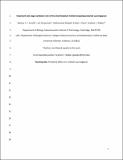Important Late-Stage Symbiotic Role of the Sinorhizobium Meliloti Exopolysaccharide Succinoglycan
Author(s)
Chen, Esther J.; Penterman, Jon; Shabab, Mohammed; Arnold, Markus F. F.; Walker, Graham C.
DownloadArnold et al. 2018.pdf (4.536Mb)
OPEN_ACCESS_POLICY
Open Access Policy
Creative Commons Attribution-Noncommercial-Share Alike
Terms of use
Metadata
Show full item recordAbstract
Sinorhizobium meliloti enters into beneficial symbiotic interactions with Medicago species of legumes. Bacterial exopolysaccharides play critical signaling roles in infection thread initiation and growth during the early stages of root nodule formation. After endocytosis of S. meliloti by plant cells in the developing nodule, plant-derived nodule-specific cysteine-rich (NCR) peptides mediate terminal differentiation of the bacteria into nitrogen-fixing bacteroids. Previous transcriptional studies showed that the intensively studied cationic peptide NCR247 induces expression of the exo genes that encode the proteins required for succinoglycan biosynthesis. In addition, genetic studies have shown that some exo mutants exhibit increased sensitivity to the antimicrobial action of NCR247. Therefore, we investigated whether the symbiotically active S. meliloti exopolysaccharide succinoglycan can protect S. meliloti against the antimicrobial activity of NCR247. We discovered that high-molecular-weight forms of succinoglycan have the ability to protect S. meliloti from the antimicrobial action of the NCR247 peptide but low-molecular-weight forms of wild-type succinoglycan do not. The protective function of high-molecular-weight succinoglycan occurs via direct molecular interactions between anionic succinoglycan and the cationic NCR247 peptide, but this interaction is not chiral. Taken together, our observations suggest that S. meliloti exopolysaccharides not only may be critical during early stages of nodule invasion but also are upregulated at a late stage of symbiosis to protect bacteria against the bactericidal action of cationic NCR peptides. Our findings represent an important step forward in fully understanding the complete set of exopolysaccharide functions during legume symbiosis.
Date issued
2018-06Department
Massachusetts Institute of Technology. Department of BiologyJournal
Journal of Bacteriology
Publisher
American Society for Microbiology
Citation
Arnold, Markus F. F. et al. “Important Late-Stage Symbiotic Role of the Sinorhizobium Meliloti Exopolysaccharide Succinoglycan.” Edited by Yves V. Brun. Journal of Bacteriology 200, 13 (April 2018): e00665–17 © 2018 American Society for Microbiology
Version: Author's final manuscript
ISSN
0021-9193
1098-5530